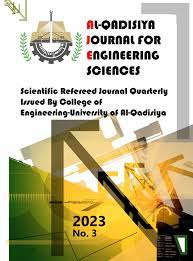Abstract
This study presents experimental and theoretical investigation of the overall shear behavior of reinforced concrete deep beams made from hybrid concrete strength : Normal strength concrete (NSC) in tension zone and high strength concrete (HSC) in compression zone. The experimental work included testing of nine models of hybrid reinforced concrete deep beams under the effect of two point loads. One of the beams was tested as pilot and the other eight beams were divided into two groups namely group (A) and group (B) to study the effects of the following parameters: (HSC) the layer thickness, the effect of presence of web reinforcement and method of casting (i.e. monolithically or at different times), on the ultimate shear strength, the cracking load, the cracking pattern, the deflection, the ductility and failure modes.
The experimental test results obtained from the adopted hybridization technique of (HSC) and (NSC) have shown that for beams made from (HSC) (about 45MPa) with a layer in compression zone of thickness (25 - 50)% of total beam depth, the ultimate shear strength was increased about (11.2 - 19.5)% for beams without web reinforcement and (16.75 - 22.25)% for beams with minimum web reinforcement. It has also shown that, the first cracking load was increased about (32.8 - 48)% and (43.4 - 57.9)% for beams without and with web reinforcement, respectively.
The hybrid concrete beams that cast monolithically, have exhibited an increase in ductility about (13.3- 22.6) % and (17.3 - 26.3) % for specimens without and with web reinforcement, respectively. While, the hybrid concrete beams with construction joint and epoxy resin layer of thickness about (1mm), have exhibited larger increasing in ductility about (28.7%) and (30.2%) for specimens without and with web reinforcement, respectively.
The experimental test results obtained from the adopted hybridization technique of (HSC) and (NSC) have shown that for beams made from (HSC) (about 45MPa) with a layer in compression zone of thickness (25 - 50)% of total beam depth, the ultimate shear strength was increased about (11.2 - 19.5)% for beams without web reinforcement and (16.75 - 22.25)% for beams with minimum web reinforcement. It has also shown that, the first cracking load was increased about (32.8 - 48)% and (43.4 - 57.9)% for beams without and with web reinforcement, respectively.
The hybrid concrete beams that cast monolithically, have exhibited an increase in ductility about (13.3- 22.6) % and (17.3 - 26.3) % for specimens without and with web reinforcement, respectively. While, the hybrid concrete beams with construction joint and epoxy resin layer of thickness about (1mm), have exhibited larger increasing in ductility about (28.7%) and (30.2%) for specimens without and with web reinforcement, respectively.
Abstract
تقدم هذه الدراسة بح ث ا نظري ا وعملي ا لسلوك القص العام في العتبات الخرسانية المسلحة العميقة المصنوعة من الخرسانة
الهجينة :الخرسانة عادية المقاومة) NSC ( في منطقة الشد والخرسانة عالية المقاومة ) HSC ( في منطقة الضغط . تضمن الجزء
العملي فحص تسعة موديلات من الأعتاب الخرسانية المسلحة العميقة الهجينة تحت تأثير فحص نقطي ثنائي التحميل . أحد هذه
العتبات فحصت كعتبة إرشادية والعتبات الثمانية الأخرى قسمت إلى مجموعتين ) A و B ( لدراسة تأثيرات: سمك طبقة
الخرسانة عالية المقاومة ) HSC ( , وجود حديد تسليح الوترة ) web ( وطريقة الصب مباشرة أو في أوقات مختلفة )أي وجود
مفصل إنشائي أفقي( على مقاومة القص العظمى, حمل التشقق, نمط التشقق, الهطول, المطاوعة )المطيلية( وأنماط الفشل.
نتائج البرنامج العملي المستحصلة من تقنية التهجين المتبناة للخرسانة العادية والعالية المقاومة بينت إن العتبات المصنوعة من
الخرسانة العالية المقاومة ) (45 MPa في منطقة الضغط بسمك ) 25 - 50 (% من عمق العتبة الكلي مقاومة القص العظمى لها
زادت بنسبة حوالي ) 11.2 - 19.5 (% للعتبات بدون تسليح الوترة و ) 16.75 - 22.25 (% للعتبات ذات تسليح الوترة ,على
التوالي. كذلك حمل التشقق الأول زاد بنسبة حوالي ) 32.8 - 48 (% و) 43.4 - 57.9 (% للعتبات بدون ومع تسليح الوترة ,
على التوالي.
الهجينة :الخرسانة عادية المقاومة) NSC ( في منطقة الشد والخرسانة عالية المقاومة ) HSC ( في منطقة الضغط . تضمن الجزء
العملي فحص تسعة موديلات من الأعتاب الخرسانية المسلحة العميقة الهجينة تحت تأثير فحص نقطي ثنائي التحميل . أحد هذه
العتبات فحصت كعتبة إرشادية والعتبات الثمانية الأخرى قسمت إلى مجموعتين ) A و B ( لدراسة تأثيرات: سمك طبقة
الخرسانة عالية المقاومة ) HSC ( , وجود حديد تسليح الوترة ) web ( وطريقة الصب مباشرة أو في أوقات مختلفة )أي وجود
مفصل إنشائي أفقي( على مقاومة القص العظمى, حمل التشقق, نمط التشقق, الهطول, المطاوعة )المطيلية( وأنماط الفشل.
نتائج البرنامج العملي المستحصلة من تقنية التهجين المتبناة للخرسانة العادية والعالية المقاومة بينت إن العتبات المصنوعة من
الخرسانة العالية المقاومة ) (45 MPa في منطقة الضغط بسمك ) 25 - 50 (% من عمق العتبة الكلي مقاومة القص العظمى لها
زادت بنسبة حوالي ) 11.2 - 19.5 (% للعتبات بدون تسليح الوترة و ) 16.75 - 22.25 (% للعتبات ذات تسليح الوترة ,على
التوالي. كذلك حمل التشقق الأول زاد بنسبة حوالي ) 32.8 - 48 (% و) 43.4 - 57.9 (% للعتبات بدون ومع تسليح الوترة ,
على التوالي.
